Photo from the Field: Rolling out the Red Carpet
by Ben Wurst, Habitat Program Manager
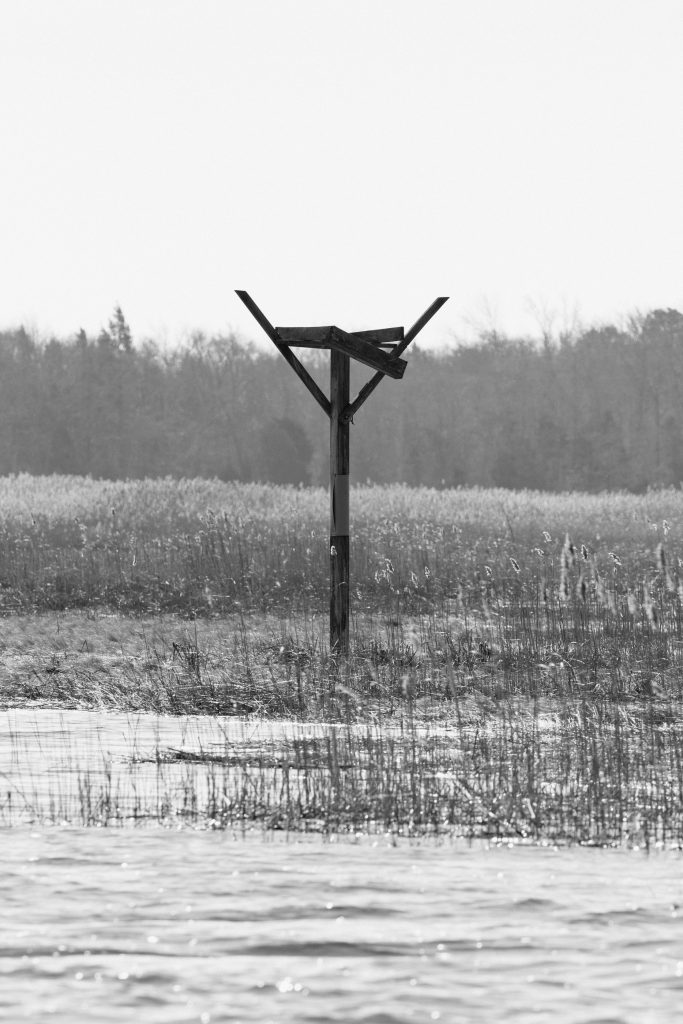
by Ben Wurst, Habitat Program Manager

by Meaghan Lyon, Wildlife Biologist
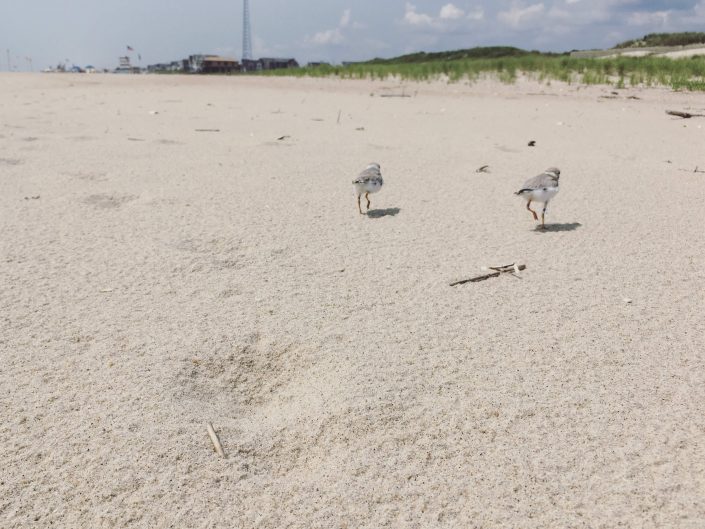
Although the Sea Girt National Guard Training Center (NGTC) has just a small section of beach to manage, their efforts there with threatened and endangered species has been big. Conserve Wildlife Foundation of New Jersey has been a partner in these efforts, monitoring the piping plovers that nest on this beach during the breeding season and assisting in the planning of habitat enhancements. The protection area at the NGTC has been the nesting site of a piping plover pair for the past three breeding seasons and it is likely they will return again this spring, all while supporting the military and recreational missions of the New Jersey Army National Guard.
Continue reading “Habitat Enhancements for Rare Species at the Sea Girt National Guard Training Center”by Todd Pover, Senior Wildlife Biologist
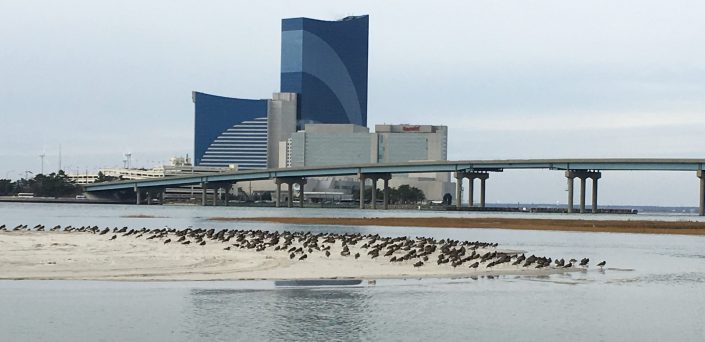
Most people are surprised to hear that American oystercatchers are present in New Jersey in the winter. They usually associate the charismatic shorebird as a breeding species here. Our state’s wintering oystercatchers, a combination of breeders from further north and our own, are at the northern extent of the Atlantic coast wintering range.
Continue reading “CWF Assists the State with Wintering American Oystercatcher Survey”By Todd Pover, Senior Wildlife Biologist
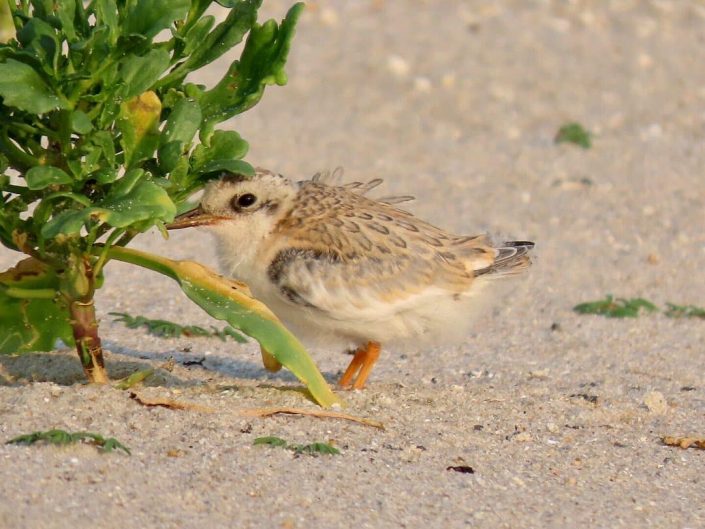
With 2021 coming to an end, we thought it would be fun to look back at this year’s beach nesting bird season in New Jersey, focusing on some of the surprises.
At the top of the list is the huge jump in our piping plover breeding population, up to 137 pairs from just 103 in 2020, an unprecedented 33% increase in one year and the third highest on record for the state since federal listing. This was a much-needed bump, as productivity has been high over the past few years, but we weren’t seeing any sustained growth in the population as a result as would be typical. So, when the final pair number was tallied this year, we were both relieved and surprised at how big it was! The challenge now will be to maintain that higher level or increase it even more, as it has fluctuated up and down quite a bit in recent years.
Continue reading “A Year of Surprises – New Jersey’s 2021 Beach Nesting Bird Season”By Meghan Kolk, Wildlife Biologist

This fall CWF worked with the staff at the Trailside Nature and Science Center at Watchung Reservation in Union County, New Jersey to restore their Certified Wildlife Habitat. A Certified Wildlife Habitat must include sources of food, water, cover and places to raise young, and must be maintained using sustainable practices. Their garden had suffered from years of neglect and had become overgrown and choked out by weeds.
The first task was to tackle the major cleanup with the goals of opening the garden up to more sunlight, making room for new plantings, and giving the garden a fresh and clean appearance. CWF staff, interns and volunteers joined the Trailside Center’s staff and spent a day pulling weeds, digging up unwanted and overgrown plants, trimming shrubs and trees, clearing vines from trees, and raking and blowing leaves. Dead, dying, or damaged trees and shrubs were cut down. We left the healthy and beneficial trees, shrubs and herbaceous plants that will be the backbone of the refreshed garden. At the end of the day, the result of cleanup was remarkable. Sunlight can now reach the ground, and the garden became a clean slate to add new plantings that will benefit birds, bees, butterflies, and other wildlife.


Trailside garden before and after cleanup.
The next step was to install a new deer fence around the garden. The Trailside Center lies within a wooded area and deer are drawn to the garden to munch on the shrubs and plants. In order to keep deer from destroying the garden, while allowing birds and other wildlife to utilize it, we installed a new eight-foot-high deer fence around the garden to replace one that had fallen down years ago. At the same time, we planted some new trees and shrubs in the garden that will be able to grow without the pressure of deer browse. We planted only native species that will attract birds, hummingbirds, bees, and butterflies to the garden.
In the spring, we will return to plant native herbaceous perennial plants that will also benefit birds, hummingbirds, bees, and butterflies. We will be sure to plant some host species for native butterflies, such as milkweed for monarchs. We plan to make a corner of the garden that caters specifically to hummingbirds. The garden is already home to a beautiful man-made creek flowing into a pond that draws birds and frogs. Several types of bird feeders, squirrel feeders and nest boxes are scattered throughout the garden as well. The restored garden will be unveiled this spring for visitors to observe through the viewing windows inside the Trailside Center.
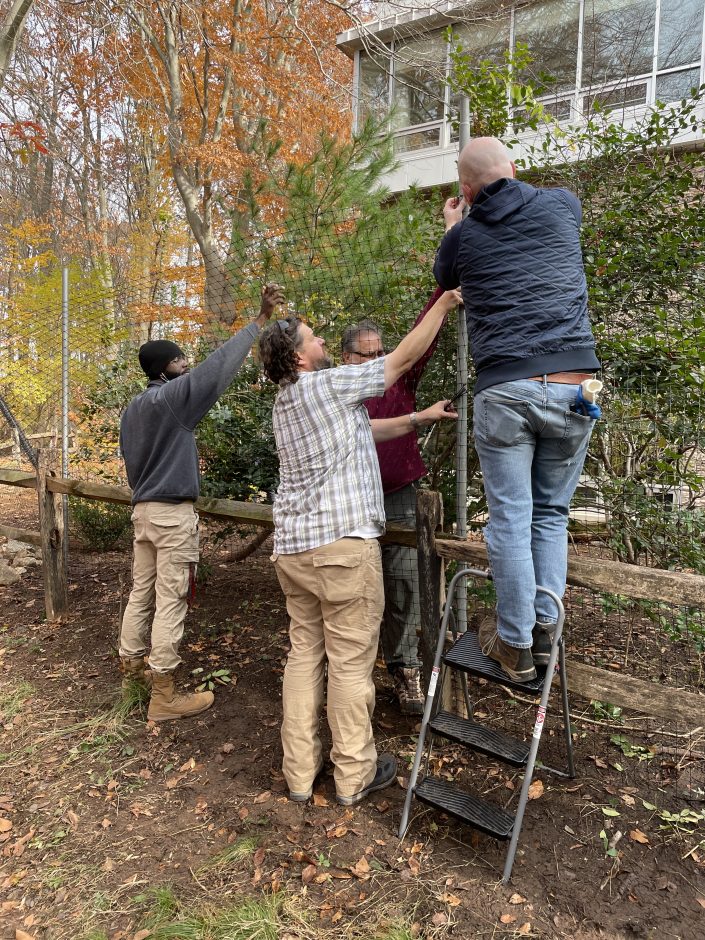
By Meghan Kolk, CWF Wildlife Biologist
The Coastal Barn Owl Project team is gearing up for another round of nest box installations in coastal southern New Jersey. After a successful fundraising appeal, we can now thank our donors by adding more potential nesting opportunities for barn owls, a species in population decline.
Our fourth and most recent box was just installed on October 22 in the saltmarshes of Cape May County. With each install, the team is becoming more efficient, and we hope to get several more boxes up in key locations before early spring when the owls begin their search for suitable nesting sites.
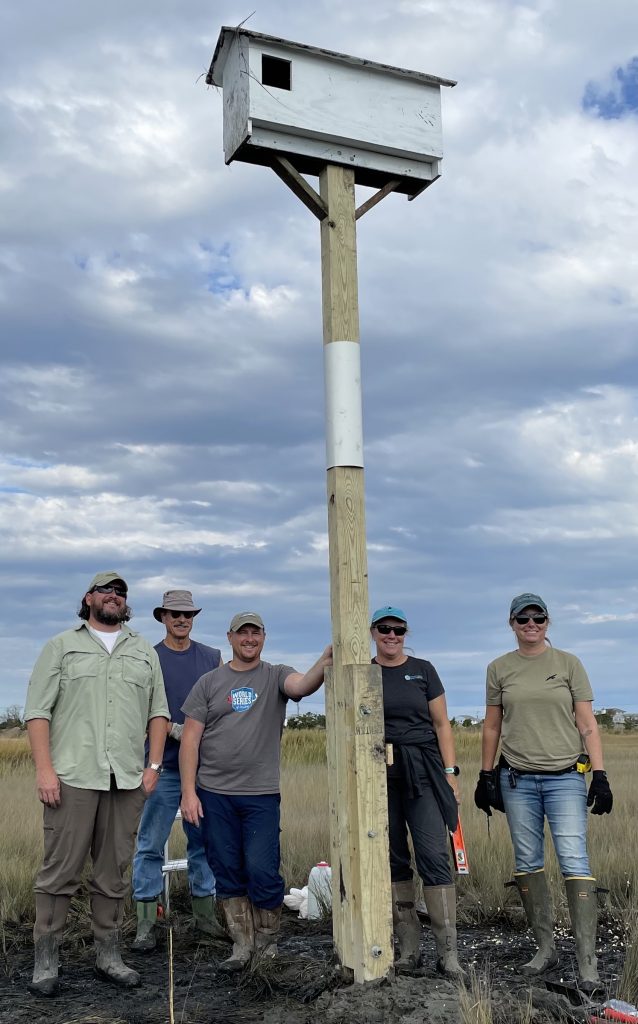
by Christine Healy, Wildlife Biologist

How do you survey for animals that spend most of their time hidden under leaf litter or wedged between fallen tree limbs and rocks?
In the case of reptiles and amphibians, the answer is to use coverboards!
Coverboards are materials that are intentionally placed within a potential habitat, often along ecotones (where different habitat types- e.g., wetland and forest, field and forest, etc. come together) that trap moisture and retain heat, creating favorable conditions for our “cold-blooded” (ectothermic) friends. Researchers often arrange coverboards in long transects or arrays and collect data on the diversity of the community underneath the boards as compared to the surrounding environment. This technique was used by NJDEP Division of Fish and Wildlife to survey for herptiles in 17 wildlife management areas in the early 2000s (Golden, 2004). A total of 30 species were recorded during the first year of the study, including long-tailed salamanders, pine barrens tree frogs, and northern pine snakes, all of which are listed as threatened in New Jersey.
Continue reading “Uncovering Urban Reptile and Amphibian Diversity”By Todd Pover, Senior Wildlife Biologist

The 2021 New Jersey piping plover breeding season was a classic “good news, bad news” result. According to the annual report released by the state’s Endangered and Nongame Species Program earlier this month, the breeding population increased to 137 pairs in 2021, third highest since federal listing in 1986. That is an unprecedented 33% rise over the previous year and just short of the record high of 144 pairs in 2003. On the downside, the number of chicks fledged statewide was just 0.85 chicks per pair, the lowest since 2013 and about half of the 1.50 federal recovery goal. The low productivity was largely the result of a severe Memorial Day weekend nor’easter and persistent predator activity throughout the season.
Holgate, a unit of the Edwin B. Forsythe National Wildlife Refuge, hosted 46 pairs, the most in the state. This site, which is monitored and managed by CWF through a cooperative agreement with the Refuge, has seen an astounding increase in piping plover pairs in recent years, up about 2.5 times from the 18 pairs it had in 2018. CWF also monitors Little Beach, the adjacent Refuge-owned site, where another 13 pairs nested in 2021. Combined the two sites had 59 nesting pairs, a new record, by far, for the Refuge. Unfortunately, like the statewide results, productivity was very low this year at both Refuge sites, combined only 0.80 chicks fledged per pair, about half the rate just a year ago. The Memorial Day weekend nor’easter flooded those sites, wiping out most nests, and although most of the pairs nested again afterwards, many of those renests (or hatched chicks) were lost to predators, especially coyotes at Holgate.
CWF also oversaw piping plover breeding at the National Guard Training Center, which had just one pair in 2021, but that nest successfully hatched and fledged three chicks, helping boost the state average. Overall, CWF was responsible for monitoring 44% of the statewide population, giving it a significant role in helping guide conservation of this highly vulnerable state endangered (and federally threatened) species.
Although CWF does not conduct the daily on-the-ground monitoring and management of piping plovers at the Barnegat Inlet nesting site, it was a co-leader of the habitat restoration that was completed there two winters ago, and as such has had a big role in the nesting outcomes at the site. The number of pairs using the site has noticeably grown, up to five pairs in 2021 from just one pair when the project began. Productivity has also been consistently high at the restoration site and 2021 was no different with the pairs exceeding the federal recovery goal and statewide average with 1.6 chicks fledged per pair this year.
With the breeding results for 2021 now “in the books”, we are already looking forward to next year. The biggest question will be whether the state can sustain the progress towards recovery it made this year, especially given the big drop in productivity, which typically drives population. But for now, all we can do is wait until next spring to learn the answer to that question.
by Ben Wurst, Habitat Program Manager
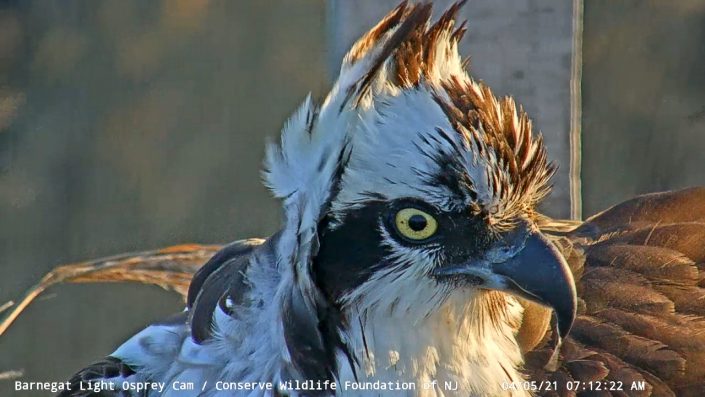
By far, this was the most viewed season of the Barnegat Light Osprey Cam, with over 360,000 views and 111,000 hours watched! It was a season of change. Viewers throughout the world watched as the mated pair successfully fledged two healthy young. We witnessed the trials and tribulations of a new pair, especially the female, who we believe attempted reproduction for the first time in her life. We saw that life as a young osprey was not always guaranteed, which is something we rarely get to witness but know is quite common at many nests throughout the world; however, with an experienced male and plentiful prey, the surviving young thrived. As we work on a season long highlight video, here is a brief summary of their nesting season.
Continue reading “Two are sometimes better than three”By: Meghan Kolk, CWF Wildlife Biologist
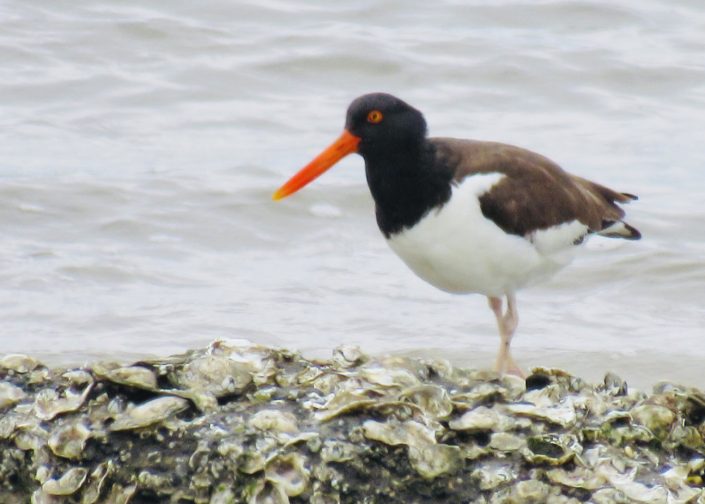
The Delaware Bay is well known for the spectacular phenomenon of spawning horseshoe crabs and migrating red knots every May, but in recent years the American oystercatchers (Haematopus palliatus) have also discovered the allure of the Bayshore and made it their home. American oystercatchers, a State Species of Special Concern, have been monitored and managed by CWF and the NJDFW’s Endangered and Non-game Species Program along the Atlantic coast beaches for nearly two decades, resulting in a steady population increase. However, the population that breeds along the Bayshore, first documented in 2016, has not received the same attention and had never been fully surveyed until this year.
CWF’s interest in this newly discovered population led to a small pilot study of a few known breeding pairs in 2018. Then this past May, we launched a bay-wide survey of the sandy beaches of the New Jersey side of the Bay from Cape May Point up to Seabreeze, the northernmost beach in Cumberland County. The purpose of the bay-wide survey is to determine a baseline of the number and distribution of breeding pairs along the Bayshore. The data gathered from this survey will add to the Statewide population estimate and help determine the amount of time and funding needed to fully monitor and manage the Bay’s population. More monitoring will be necessary to assess risk factors and reproductive success. Reproductive success can then be maximized by managing for risk factors such human disturbance, predation and tidal flooding.
This survey was made possible due to the efforts of dedicated volunteers and could not have been completed without their help. Unlike the Atlantic coast, the Bayshore beaches are often difficult to access, and many can only be reached by boat, making this survey more challenging. In fact, two sites that we planned to survey proved to be too difficult to reach and were skipped for this year. Each of the 33 remaining sites were surveyed just once within a specific timeframe, giving only a snapshot of the breeding season. We hope to be able to collect much more information in the future when more funding for this project is available. Based on the survey that was conducted, 13 pairs were documented at 8 different sites and 8 nests were documented at 5 different sites.
In addition to the formal survey, I was able to collect some observations as I spent every day in May on the Bay working with red knots. I took notice of the prey items that the oystercatchers were choosing. I often observed them feasting on oysters, which were plucked off exposed rubble at low tide. They also spent time at the man-made oyster reefs that were constructed at several beaches to act as breakwaters to slow the erosion of beaches. They also favored ribbed mussel beds, which become exposed as the tide recedes. The most interesting foraging behavior I witnessed was an oystercatcher plucking a fresh slipper shell off a horseshoe crab as it came to shore to spawn. It seems the Bay offers a variety of good food sources for a bird that mainly preys on bivalve mollusks.
I also noticed that flocks of up to 11 oystercatchers were traveling together up and down the Bayshore. This is a peculiar behavior since oystercatchers are highly territorial during the breeding season and are typically only seen in flocks once the breeding season is over. Could it be that the Bayshore is a popular spot for non-breeding young adults to hang out?
So much more research is needed to answer the many questions we have about the mysterious Bayshore oystercatchers.